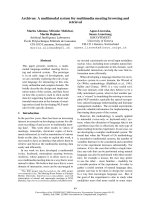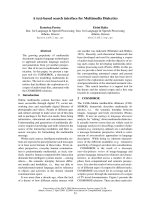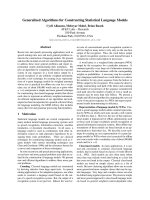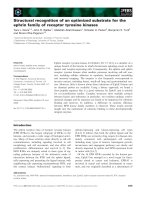Optimized algorithms for multimedia streaming
Bạn đang xem bản rút gọn của tài liệu. Xem và tải ngay bản đầy đủ của tài liệu tại đây (1 MB, 166 trang )
OPTIMIZED ALGORITHMS FOR
MULTIMEDIA STREAMING
LI YONGFENG
(M. Eng.), TJU
A THESIS SUBMITTED
FOR THE DEGREE OF DOCTOR OF PHILOSOPHY
DEPARTMENT OF ELECTRICAL & COMPUTER
ENGINEERING
NATIONAL UNIVERSITY OF SINGAPORE
2009
To my parents and my wife
ACKNOWLEDGMENT
i
ACKNOWLEDGMENT
As a graduating doctoral candidate, I would like to take an opportunity of this
time to express my gratitude to the people who have been helping, encouraging,
supporting and accompanying me through these years.
First and foremost, I would like to thank my supervisor, Associate Professor Ong
Kok Wee, Kenneth, for motivating and guiding my research. It has always been a
privilege to work with him because he has a knack for giving proper guidance, yet
enough freedom to explore. His insightful feedback often provides fresh
perspective. I am deeply grateful for having learned from the best. Moreover, I am
very thankful for his help in my job searching.
This dissertation, along with all other accomplishments of mine, is dedicated to my
parents, who have supported me for all the past years and will still sustain me for the
future years. I owe them much more than I could ever express in words.
My deepest thanks to my beautiful wife: huahan for her love and moral support.
She shares with me all the happiness and difficulties. With her love, I am always
brave to face any frustration and challenge. She possesses my heart and my future
belongs to her. I am determined to bring her and my family a better life.
ACKNOWLEDGMENT
ii
I also enjoy collaborating and living with many friends. Finally, I would like to
thank the National University of Singapore for funding my research.
TABLE OF CONTENT
iii
TABLE OF CONTENT
ACKNOWLEDGMENT i
TABLE OF CONTENT iii
SUMMARY vi
LIST OF TABLES viii
LIST OF FIGURES ix
ACRONYMS xi
Chapter 1 : INTRODUCTION 1
1.1 Motivation 1
1.2 Thesis Contribution 6
1.3 Outline 8
Chapter 2 : INTERNET VIDEO STREAMING 10
2.1 Protocols 10
2.1.1 RTP 11
2.1.2 RTCP 12
2.1.3 RTSP 13
2.1.4 TFRC 14
2.2 Scalable Video Coding (SVC) Methods 16
2.2.1 SVC characteristics and development history 16
2.2.2 MPEG-4 Fine Granular Scalability (FGS) 18
2.3 Internet Video Streaming Systems 19
2.4 Research Challenges 23
Chapter 3 : ADAPTIVE VIDEO STREAMING VIA OPTIMIZED
COMPENSATION 28
TABLE OF CONTENT
iv
3.1 Background 29
3.2 General Problem Description 33
3.3 Adaptive Compensation Method 38
3.3.1 Video compensation model 38
3.3.2 Optimized compensation segment 39
3.4 Performance Evaluation 44
3.4.1 Simulation settings 44
3.4.2 Adaptive video streaming scenarios 46
3.4.3 Effect of client buffer utilization 49
3.4.4 Effect of client buffer size 50
3.4.5 Video quality improvement 51
3.5 Concluding Remarks 53
Chapter 4 : HIERARCHICAL VIDEO ADAPTATION 54
4.1 Background 54
4.2 Video Adaptation Concept Model 60
4.3 General Problem Description 62
4.4 Content-Aware Scene Level Model 64
4.4.1 Scene level optimization model 64
4.4.2 Adaptation algorithm for video scenes 67
4.5 SNR-Temporal Resolution Optimized Frame Level Model 68
4.5.1 Frame level multi-objective optimization model 68
4.5.2 Adaptation algorithm for video frames 70
4.6 Performance Evaluation 74
4.6.1 Simulation settings 75
4.6.2 Fair adaptation for video scenes 76
4.6.3 Effect of preserved temporal resolution 79
4.6.4 Perceptual quality improvement 81
4.6.5 Adaptation granularity comparison 86
4.6.6 Computational efficiency comparison 87
4.7 Concluding Remarks 89
Chapter 5 : OPTIMIZED CACHE MANAGEMENT 90
5.1 Background 90
TABLE OF CONTENT
v
5.2 General Problem Description 97
5.3 Proxy Caching Concept Model 98
5.4 Scalable Video Transmission Scheme 102
5.5 Optimized Proxy Caching Strategy 105
5.5.1 Multi-objective optimization model 105
5.5.2 Heuristic optimization method 110
5.6 Performance Evaluation 114
5.6.1 Simulation settings 115
5.6.2 Effect of user request rates and proxy cache size 117
5.6.3 Bandwidth cost reduction 120
5.6.4 Tradeoff between bandwidth cost and access latency 130
5.7 Concluding Remarks 132
Chapter 6 : CONCLUSIONS AND FUTURE RESEARCH 133
6.1 Conclusions 134
6.2 Major Difficulties Encountered 138
6.3 Suggestions for Future Research 141
Bibliography 144
Publication List 152
SUMMARY
vi
SUMMARY
Since the introduction of video streaming a decade ago, it has been experiencing a
dramatic growth and becoming an important multimedia communication method
over Internet. Video streaming applications require real-time data delivery in order
to provide continuous playback at clients with good perceptual quality.
Nevertheless, lack of system resources and quality of service (QoS) support from
Internet pose many issues that need to be resolved, such as how to deliver scalable
coded video over networks with varying bandwidth, how to cater to heterogeneous
requests simultaneously, and how to cache video efficiently. This research includes
studies of different components of a video streaming system, and proposes several
optimization models and algorithms to improve system performance in the presence
of mutative environment and constrained resources.
In the first part of this dissertation, we present a compensation method for the
delivery of scalable coded video. Our target is to improve the video quality in the
presence of bandwidth fluctuation. In our approach, the discarded video data due to
bandwidth degradation has the chance to be compensated to clients if both real-time
and resource constraints can be satisfied.
In the second part, we utilize the hierarchical bit stream structure of scalable coded
video and propose an optimized video adaptation scheme. By exploring the scene
SUMMARY
vii
complexity and scene priority, we minimize the quality distortion and quality
fluctuation of the adapted video stream simultaneously. In our approach, the
adaptation is carried out hierarchically on both video scene level and video frame
level with low computational complexity.
In the last part, we present a complete solution for proxy to cache and deliver
scalable coded video in streaming system. The proposed caching scheme allows
different video layers to be cached with various time spans based on user access
behaviors, video characteristics, and transmission cost rates. A proxy stores video
segments and coordinates video delivery, such that overall bandwidth cost and user
access latency are minimized simultaneously.
The dissertation validates the proposed models, algorithms, schemes and explores
their characteristics through extensive simulations.
LIST OF TABLES
viii
LIST OF TABLES
Table 3-I: Parameters of the adaptive video transmission scenario and
compensation model 36
Table 3-II: Simulation parameters 45
Table 3-III: Simulation parameters for adaptive video streaming scenarios 47
Table 4-I: SLM parameters 65
Table 4-II: FLM parameters 69
Table 4-III: Content characteristics of CIF video scenes 76
Table 4-IV: Simulation parameters 76
Table 4-V: Motion vector and texture size of video objects 77
Table 5-I: Parameters of proxy caching concept model 101
Table 5-II: Simulation parameters for single video object case 116
Table 5-III: Simulation parameters for multiple video objects case 117
LIST OF FIGURES
ix
LIST OF FIGURES
Figure 2-I: Typical RTSP/RTP/RTCP protocol stack 14
Figure 2-II: Structure of hybrid temporal-SNR scalability 19
Figure 2-III: A typical proxy-assisted video streaming architecture 22
Figure 2-IV: Streaming proxy structure 25
Figure 3-I: Transmission scenario with bandwidth fluctuation 36
Figure 3-II: Network topology for the simulation 45
Figure 3-III: Video streaming scenarios with adaptive compensation method 48
Figure 3-IV: Effect of buffer utilization (b(t)/C) on the compensation effect (C
e
) 50
Figure 3-V: Effect of buffer size (C) on the compensation effect (C
e
) 51
Figure 3-VI: Quality improvement achieved by the transmission scheme with ACM
53
Figure 4-I: Video adaptation concept model 61
Figure 4-II: Video adaptation algorithm for SLM 67
Figure 4-III: Video adaptation algorithm for FLM 71
Figure 4-IV: Performance of video adaptation algorithm for scene level model 78
Figure 4-V: Effect of preserved B frames on the average perceptual quality 80
Figure 4-VI: Comparison of average quality among adaptation schemes 82
Figure 4-VII: Comparison of quality variance among adaptation schemes 85
Figure 4-VIII: Comparison of bit rate match discrepancy among adaptation
schemes 87
Figure 4-IX: Comparison of average computation time per frame among adaptation
schemes 88
LIST OF FIGURES
x
Figure 5-I: Illustration of cached segments of one video object on proxy 99
Figure 5-II: Simplified proxy caching scenario for one video object
ω
101
Figure 5-III: Heuristic algorithms to derive Pareto optimal set 112
Figure 5-IV: Effects of proxy cache size and request rates on the bandwidth cost
119
Figure 5-V: Bandwidth cost vs. cache size under four user request distributions123
Figure 5-VI: Backbone bandwidth cost reduction achieved by OCS 126
Figure 5-VII: Overall bandwidth cost reductions achieved by OCS 129
Figure 5-VIII: Bandwidth cost comparison among different schemes. 130
Figure 5-IX: Pareto frontier chart 131
ACRONYMS
xi
ACRONYMS
ACM: adaptive compensation method
BL: base layer
CBR: constant bit rate
CDN: content distribution networks
CM: compensation model
EL: enhancement layer
FDDC: frame-dropping with drift compensation
FGS: fine granular scalability
FGST: temporal FGS
FLM: frame level model
OAS: optimized adaptation scheme
OCS: optimized caching strategy
P2P: peer-to-peer
PSNR: peak signal-to-noise ratio
QoS: quality of service
R-D: rate-distortion
RQ: re-quantization
RTCP: real-time control protocol
RTP: real-time transport protocol
RTSP: real-time streaming protocol
ACRONYMS
xii
SFD: simple frame-dropping
SLM: scene level model
SNR: signal-to-noise ratio
SNR FGS: SNR fine granular scalability
SP: service providers
STS: scalable transmission scheme
SVC: scalable video coding
TFRC: TCP-friendly rate control
VOD: video-on-demand
WAN: wide area network
Chapter 1: INTRODUCTION
1
Chapter 1:
INTRODUCTION
The goal of this chapter is to provide a summary of the essential motivations and
contributions of the dissertation. The dissertation outline is given at the end of this
chapter as well.
1.1 Motivation
As best-effort networks (e.g. Internet) grow widespread and multimedia becomes
popular, the delivery of video over Internet attracts more interest, from academic
research to industrial development. Currently network-based video applications are
heavily demanded in the Internet market, such as distance learning, video
conferencing, Internet TV broadcasting, and video-on-demand (VOD). In these
applications, the stored video or live encoded video are transmitted across networks
upon clients’ requests. There are two modes for clients to receive the encoded video
over Internet: downloading mode and streaming mode. In downloading mode, a
client requests a specific video and downloads the entire video data before it starts
the video playback. Since client plays the video from its local storage, network
condition does not influence the playback quality of the video. Nevertheless, client
usually suffers a long and unacceptable waiting time, as well as a large consumption
Chapter 1: INTRODUCTION
2
of storage space. In streaming mode, a client initiates the video playback after a
certain part of the video data is received, and at the same time the client is
constantly receiving the missing part for future display. Since streaming mode can
overcome the aforementioned disadvantages of downloading mode, most of the
Internet video applications employ the streaming mode in spite of the possible
quality degradation incurred due to the varying network condition. Many
researches are focusing on improving the client experienced quality in streaming
mode as well.
Since existing well-developed Internet is best-effort in nature and lacks support for
quality of service (QoS) guarantee, it poses many challenging issues for real-time
video streaming, especially when many concurrent participants compete for the
precious Internet resources.
Bandwidth: Bandwidth is one of the most critical resources within Internet.
Digital video streaming usually consumes a lot of bandwidth due to the large
size of digital video and the real-time characteristic of streaming. Several
concurrent streaming sessions can impose great pressure on the common
network link and cause congestion collapse. This will degrade the streaming
throughput of the whole streaming system even if the system has high
bandwidth connectivity for both source server and clients. Moreover, the
bandwidth fluctuation during streaming session may further deteriorate the
video quality.
Chapter 1: INTRODUCTION
3
Delay: Delay is an inherited issue in packet network, e.g. Internet. Data need
time or delay to pass from source server to intermediate routers/switches, and
finally arrive at clients. Once a client plays the video, successive video data
must arrive in time. Otherwise, playback jitter will occur. Link congestion can
worsen the problem by introducing excessive and unstable delay, and further
degrade the user-perceived quality.
Loss: Packet losses are unavoidable in Internet. Video packets may be
discarded at any node along the path from source to destination, such as proxy,
router, and switch. This discard can happen because of link congestion or
excessive delay. The discarded video packets are usually not recovered in
real-time video streaming due to the timeliness of video data. When packet loss
ratio is high during streaming, the video presentation at client will become
impossible.
Besides of the aforementioned network-related issues, a real-time video streaming
application faces other challenges coming from end-systems:
Heterogeneity: Internet incorporates a diverse of clients with distinct resource
characteristics, such as bandwidth connectivity, decoding capacity, buffer size,
and monitor resolution. These clients may use the same video application in
Internet at the same time and request with different requirements. Video
services, therefore, need to be resource scalable to accommodate and
incorporate a wide range of requests simultaneously.
Chapter 1: INTRODUCTION
4
Resource depletion: All the nodes in the streaming system may experience
transient or continuous resource depletion. The depletion usually happens at
system bottleneck, such as source server, which will degrade system
performance seriously. Video applications need to focus on resolving these
bottlenecks with high priority.
As outlined above, these issues constrain the large scale deployment of video
streaming services in Internet. They need to be resolved with great care considering
of the complex and sometimes unpredictable streaming environment. Existing
researches on resolving them can be generally summarized into the following two
categories:
Network and system architecture: Adequate support from network and
effective system architecture are critical for improving the quality of video
streaming. Many novel system architectures, such as proxy-assisted and
peer-to-peer systems, have been proposed and many content distribution
networks are being deployed. Researches on the network and architectures
usually need to be validated through large scale experiments and face great
difficulties in practical deployment.
System nodes: Besides of network and architecture advancement, excellent
algorithms running over system nodes can improve the quality of video
streaming to a large extent. These nodes include end-systems such as source
server and clients, as well as intermediate network nodes such as proxies and
Chapter 1: INTRODUCTION
5
routers. For example, a source server may cut down the streaming rate to
alleviate network congestion, or adapt the video to meet client and connection
requirements. Clients may estimate bandwidth, provide prompt feedbacks, and
coordinate with each other as well. Since server is normally constrained to
doing only light processing on a per client basis, network nodes or clients can
employ similar algorithms to relieve server’s workload and hence improve the
system performance.
Additional opportunities to improve streaming quality may come from the advance
of video codec. In video applications, videos need to be compressed. Although
many International standards have been established to target for different video
applications, MPEG/ITU-T committee and many researches are constantly
developing various video compression technologies for applications related to
video streaming. One of the most important technologies is scalable video coding
(SVC). SVC exchanges its coding efficiency to provide more flexibility for
network-based video applications. With such flexibility, existing algorithms can be
improved and novel algorithms can be proposed.
The main objective of the dissertation is to investigate various advanced algorithms
based on well-established streaming architecture, so that the performance of video
streaming system can be improved to a great extent. In this dissertation, we
concentrate on the system nodes based approaches since they can be readily
Chapter 1: INTRODUCTION
6
implemented without waiting for the large scale modification of network or system
architecture. Our approaches are standards–conforming and make use of the
flexibility provided by SVC. In particular, we focus on the techniques related to the
streaming proxy, which is the key point for large scale video streaming system. To
be more specific, we investigate the characteristics of scalable coded video and
utilize the computational capacity and storage resource on streaming proxy to
resolve the challenging issues, such as network fluctuation, heterogeneous requests,
resource depletion, and so on, in large scale video streaming system, such that
system performance can be improved in terms of streaming quality and streaming
cost. By employing proposed methods and algorithms on the existing proxy servers,
we can significantly reduce system bottleneck, increase system capacity, and
improve system quality of service (QoS) with the same resources. It is also worth
noting that most of the techniques to be investigated apply to the source server
directly and effectively improve the performance of video streaming system.
1.2 Thesis Contribution
We present three topics related to video streaming, i.e. transmission, adaptation,
caching, and makes the following four contributions.
Firstly, we study the transmission problem for scalable coded video streaming
over best-effort networks, and propose an adaptive compensation method
(ACM) to reduce the negative effects of bandwidth fluctuation on the received
Chapter 1: INTRODUCTION
7
video quality at clients. The proposed ACM is a simple and easy-to-implement
solution that exploits the utilization ratio of client buffer and the characteristics
of scalable coded video stream. This solution adaptively chooses appropriate
video segments to transmit according to network conditions, and provides
improved video quality to clients during bandwidth fluctuations.
Secondly, we investigate the video adaptation problem for scalable coded video,
and propose an optimized adaptation scheme for MPEG-4 FGS video streams.
Proposed scheme explores the texture and motional complexity of video scenes
and incorporate scene priority to guarantee user-interested scenes a better
quality. We present two hierarchical adaptation algorithms on both video scene
level and video frame level to minimize quality distortion and quality
fluctuation simultaneously. Overall, an excellent compromise between
Signal-to-Noise Ratio (SNR) and temporal resolutions for the adapted video is
achieved with low computational complexity.
Thirdly, we analyze the proxy caching problem for scalable coded video
streaming and propose an optimized proxy caching scheme. This scheme tends
to allocate different storage sizes to different videos according to their
popularities and cache different layers with distinct lengths for each video. We
choose to cache the videos on proxy in a manner that both bandwidth cost and
user access latency are minimized with a certain proxy storage capacity.
Finally, we present a real-time transmission scheme for scalable coded videos.
This scheme is incorporated into proxy-assisted video streaming architecture
Chapter 1: INTRODUCTION
8
and works with the scalable proxy caching scheme seamlessly.
1.3 Outline
The remainder of the dissertation is organized as follows. Chapter 2 outlines the
Internet standards for real-time video streaming and the development of SVC. Then
a brief overview of end-to-end streaming systems and research issues is presented.
Chapter 3 describes a novel compensation method for scalable coded video
streaming. We begin with an analysis of the transmission problem due to bandwidth
fluctuation. Then a new transmission method with optimized compensation is
proposed. This method chooses to compensate proper video segments to clients at
appropriate timings and we verify its effectiveness on video quality improvement
through simulations. An efficient video adaptation scheme is presented in Chapter 4.
We incorporate video scene complexity and priority into the adaptation models, and
present efficient algorithms to obtain the optimized adaptation scheme for MPEG-4
FGS coded video stream. This scheme provides optimized user-perceived quality
for the adapted video in terms of both quality distortion and quality fluctuation.
Simulation results under various network conditions are presented. Chapter 5
proposes an optimized proxy caching strategy and corresponding transmission
scheme for scalable coded video streaming. A multi-objective optimization model
is formulated with closed-form expressions and then solved by heuristic algorithms
to obtain the caching strategy. This strategy can reduce the bandwidth cost and user
Chapter 1: INTRODUCTION
9
access latency at the same time. Simulation results demonstrate the superior
characteristics of proposed caching strategy and transmission scheme. Finally,
Chapter 6 completes the dissertation with concluding remarks and a discussion of
major difficulties encountered and future research works.
Chapter 2: INTERNET VIDEO STREAMING
10
Chapter 2: INTERNET
VIDEO STREAMING
This chapter reviews the background of scalable video streaming over a packet
network, e.g. Internet. More specifically, we review the existing network protocols
and various scalable video coding (SVC) methods for real-time video streaming. In
addition, we describe and compare two types of end-to-end video streaming
systems which are widely deployed in Internet: proxy-assisted system where source
server and clients are connected through dedicated proxies, and peer-to-peer (P2P)
system where each participant provides the functionalities of both content provider
and content consumer. Several research challenges within the proxy-assisted
streaming architecture, such as adaptive transmission, video adaptation, and proxy
caching are investigated briefly.
2.1 Protocols
Internet has been developed to connect heterogeneous networks and enable various
services over these networks. In this section, we review some important Internet
standard protocols for video streaming: Real-time Transport Protocol (RTP),
Real-time Control Protocol (RTCP), and Real-time Streaming Protocol (RTSP).
Moreover, TCP-Friendly rate control protocol (TFRC) is introduced to overcome
Chapter 2: INTERNET VIDEO STREAMING
11
the TCP/UDP disadvantages in real-time video streaming. RTP provides end-to-end
data transport functions. RTCP is a companion protocol with RTP and provides QoS
feedback to the participants of an RTP session. RTSP is a streaming session protocol
to exchange control commands between the participants of a RTSP session. Overall,
RTP/RTCP/RTSP protocol stack provides the essential functionalities for real-time
video streaming.
2.1.1 RTP
RTP is a protocol which provides end-to-end delivery services that are appropriate
for streaming video over best-effort networks with real-time characteristics
[1][2][3][4]. These services include payload type identification, sequence
numbering, timestamp, and delivery monitoring. The timestamp and sequence
numbers included in RTP packets allow the receiver to reconstruct the sender’s
packet sequence and determine the proper location of a packet. Nevertheless, RTP
itself neither addresses resource reservation nor guarantees QoS for real-time video
streaming [5]. This means that RTP does not provide any congestion control
mechanism for the delivery of video data. Hence, RTP usually works with other
network protocols such as RTCP to provide congestion control functionalities.
Typical real-time video streaming applications run RTP on top of UDP to make use
of its multiplexing and checksum services. Additional application-specific
protocols such as RTSP usually work with RTP in the form of application-specific









